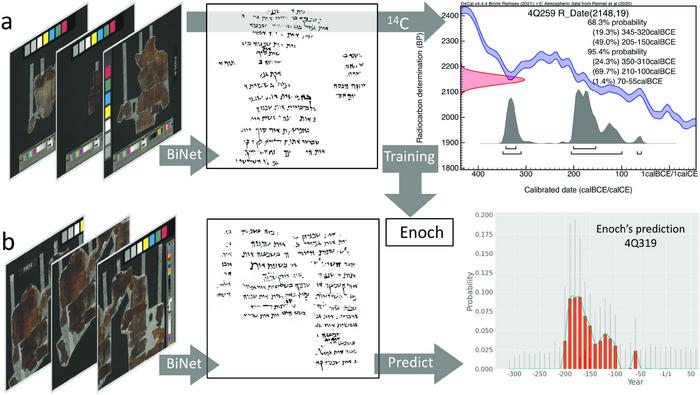In a groundbreaking fusion of ancient history and cutting-edge technology, researchers have unveiled an artificial intelligence (AI) system capable of revolutionizing how scholars date centuries-old manuscripts from the Middle East. Published on June 4, 2025, in the open-access journal PLOS One, this innovative study by Mladen Popović and colleagues from the University of Groningen, among other international collaborators, introduces “Enoch,” an AI-driven tool designed to analyze handwriting styles and offer unprecedented insight into the timelines of the Dead Sea Scrolls.
Dating ancient manuscripts has long posed a formidable challenge for historians and archaeologists alike. While some texts bear explicit dates, many crucial fragments do not, limiting precise efforts to place them within definitive historical contexts. Traditionally, scholars have relied heavily on paleography—the study of handwriting evolution—to estimate the age of such documents. Yet, this method depends on the availability of adequately dated reference samples, making it inherently subjective and prone to variability among experts.
The brilliance of Enoch lies in its hybrid approach, integrating traditional radiocarbon dating techniques with sophisticated machine learning algorithms that quantitatively analyze writing styles. To accomplish this, the team first amassed radiocarbon dating results from a carefully selected corpus of manuscripts excavated in modern-day Israel and the West Bank. Parallel to this, they captured high-resolution images of these texts, which were then processed into binary images emphasizing inked characters. This dual dataset—chronological radiocarbon ages and corresponding handwriting images—served as the training ground for Enoch’s neural network.
Machine learning excels in pattern recognition tasks ill-suited for human eyes, and by leveraging this strength, Enoch identifies subtle stylistic differences in handwriting that correlate with elapsed time. Once trained, the AI model can examine undated manuscript fragments and predict their approximate creation period based solely on handwriting style. This approach marks a significant departure from traditional paleography, introducing objectivity and reproducibility into what was once a predominantly qualitative discipline.
To rigorously validate Enoch’s efficacy, the researchers subjected 135 Dead Sea Scrolls to blind analysis, comparing AI-generated age estimates with the consensus of experienced paleographers. The results were striking: roughly 79% of the AI’s predictions aligned closely with expert assessments, while about 21% either skewed too old, too young, or were ambiguous. This level of accuracy—unprecedented for an automated system applied to such complex historical materials—underscores the method’s promise.
One of the most compelling outcomes emerging from this study is the suggestion that many Dead Sea Scrolls may be significantly older than previously believed using standard paleographic evaluations alone. Both Enoch and radiocarbon dates independently pointed towards earlier origins for multiple scroll fragments, challenging established chronologies and potentially reshaping scholarly understanding of the region’s textual transmission during antiquity.
Beyond refinement of dating the Dead Sea Scrolls, Enoch represents a versatile analytical platform with far-reaching applications. Manuscript collections worldwide, especially those partially or entirely lacking chronological metadata, stand to benefit from this method’s objective and scalable nature. By constructing robust, data-driven timelines of writing styles, historians can more confidently situate texts within their proper historical frameworks, enhancing the broader reconstruction of cultural and literary histories.
Technically, Enoch relies on convolutional neural networks—a class of deep learning algorithms adept at analyzing visual data—to discern characteristic strokes, letterforms, and stylistic flourishes inherent to specific time periods. By training on binarized ink traces extracted from full-spectrum manuscript images, the AI quantifies temporal shifts in cursive flow and letter morphology that human paleographers intuitively recognize but cannot always precisely calibrate. This capability affords Enoch a granular sensitivity to incremental stylistic changes across extended timescales.
Moreover, the researchers have meticulously accounted for uncertainties inherent in radiocarbon dating and handwriting variability by coupling probability distributions with smoothed model outputs. Red bars and blue curves in Enoch’s graphical results represent probabilistic confidence in date bins, with localized grey spikes visualizing uncertainty fluctuations. This statistical rigor bolsters the robustness of Enoch’s age predictions and offers an adaptable framework to incorporate future data and refinements.
Collaborations spanning disciplines including history, archaeology, computer science, and physics have been indispensable to this breakthrough. The project received funding from the European Research Council’s Horizon 2020 program, reflecting the European Union’s commitment to integrating innovative computational methods into humanities research. According to the authors, “the fusion of radiocarbon analysis and AI-driven handwriting style assessment unlocks a new dimension for manuscript dating… akin to a time machine opening a window onto the ancient hands behind the Biblical texts.”
Looking ahead, expanding Enoch’s training datasets with additional radiocarbon-dated manuscripts from diverse regions and periods will further enhance its predictive strength. Likewise, integrating complementary modalities—such as ink composition analytics or textual content patterns—could refine accuracy and broaden applicability. Ultimately, tools like Enoch promise to transform archival science, illuminating historical narratives long obscured by the limits of conventional scholarship.
This pioneering research thus signals a paradigm shift in the study of ancient manuscripts, melding robust empirical science with artificial intelligence to transcend previous limitations. As digital humanities gain momentum, Enoch exemplifies how machine learning can extend the reach of human inquiry deeply into history’s shadows, offering clarity where only conjecture existed before. For the Dead Sea Scrolls and countless undated texts worldwide, this represents an extraordinary leap toward understanding our shared cultural heritage in a more precise and nuanced manner than ever imagined.
Subject of Research: Not applicable
Article Title: Dating ancient manuscripts using radiocarbon and AI-based writing style analysis
News Publication Date: 4-Jun-2025
Web References: http://dx.doi.org/10.1371/journal.pone.0323185
References: Popović M, Dhali MA, Schomaker L, van der Plicht J, Lund Rasmussen K, La Nasa J, et al. (2025) Dating ancient manuscripts using radiocarbon and AI-based writing style analysis. PLoS One 20(6): e0323185.
Image Credits: Popović et al., 2025, PLOS One, CC-BY 4.0
Keywords: AI, handwriting analysis, radiocarbon dating, Dead Sea Scrolls, ancient manuscripts, paleography, machine learning, computational modeling




